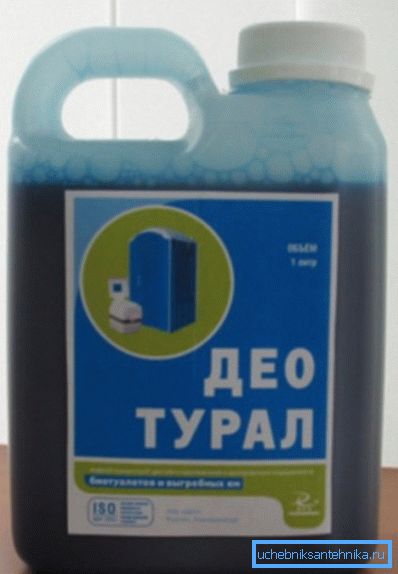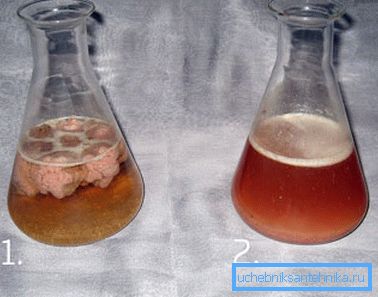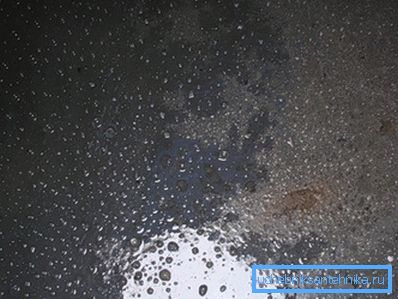Sewage bacteria - efficient cleaning
Many people are accustomed to the fact that bacteria are something harmful and even dangerous. However, there are beneficial bacteria, in particular, not so long ago, sewage purification technology was developed using microorganisms with aseptic properties.
This article is dedicated to her.

Features of biological products
Operating principle
Microorganisms for sewage in the air are in a sort of “sleeping” state, but as soon as they get into the water they begin to activate. As a result, within a few hours after being added to the sewage system, they begin to destroy all the organic compounds present in the sewer line.
Thus, adding bacteria to the sewage system, you can achieve the following results:
- Stop the process of vital activity of organic compounds;
- Eliminate gas formation;
- Get rid of unpleasant smell from sewage.
The result of the biological product will be noticeable after four to five hours. This is due to the fact that after adding bacteria to the sewage system, they multiply rapidly, with the result that their number increases several times, respectively, the cleaning process is accelerated.

After completion of the cleaning process, bioactivators turn into a liquid homogeneous mass without color and smell.
The advantages of the technology of sewage purification with biological products
Among the main advantages of using bioactivators are the following points:
| Efficiency | The use of microorganisms can significantly save on the use of mechanical cleaning filters. Filters have to constantly change, though their price is higher than the cost of bacteria. In addition, the filter units work quite noisy. |
| Environmental friendliness | The use of microorganisms eliminates the use of reagents and all kinds of chemicals. Chemicals, as is well known, have a negative impact on the ecological situation; in addition, the waste they have processed cannot be reused. Microorganisms are harmless to humans, flora and fauna, so the waste they processed can be poured into compost. |
| Security | This sewage cleaning technology does not destroy concrete and plastic. |
Types of bioactivators
All existing living microorganisms that are used for cleaning water supply and sewage systems are of two types:
- Anaerobic;
- Aerobic.
Now let's take a closer look at the features of these two types of bacteria.

Aerobic
A distinctive feature of anaerobic microorganisms is the need for a large amount of oxygen, without which their vital activity is impossible. This group has the largest number, and is present in the environment.
Such bacteria are used in the production of:
- Antibacterial drugs;
- Enzymes;
- Organic acid.
After entering the sewage system, aerobic bioactivators form a silt mass. The cleaning process is quite intensive, as in combination with components that are in sewage waste, bacteria multiply very quickly.
Tip! At the end of the treatment, the drains can be brought into the gutter without additional disinfection or into the well with drainage.
After cleaning the system with such biologics, even unpleasant odors are destroyed. After completion of the process does not remain sediment.
Anaerobic
Unlike previous types of bioactivators, anaerobic microorganisms do not need oxygen. As a result, the principle of sewage cleaning with their use is based on the processes of fermentation or rotting. It should be noted that these septic agents sometimes emit a specific smell.
If we compare these microorganisms with aerobic, then their effectiveness is low, so the cleaning process takes a long time and as a result a precipitate is formed - a solidifying mass. A disposal plant will be required to remove sediment.
Note! The solid residue contains a large number of harmful microorganisms, so it cannot be used as a fertilizer.
Among other drawbacks of using anaerobic bacteria, it can be noted that the sewage system after purification requires additional purification, of course, it requires costs.

Technology cleaning sewage bacteria
The process of cleaning the sewage with bacteria is extremely simple, so it’s easy to do it yourself.
However, you should first familiarize yourself with some of the requirements that must be met in order for the cleaning to be successful:
- Along with bacteria, no other cleaning agents can be added to the sewer system.. Under the influence of acids, chlorine, aldehydes, phenols and other elements, bacteria can die. Accordingly, they will not be able to perform their function.
- The effectiveness of microorganisms is reduced to zero if disinfectants are used in parallel with them.
- The biological activity of bacteria is possible only in the environment, the temperature of which is within + 4- + 30 degrees C. Thus, in winter, trying to perform such a cleaning does not make sense. For this reason, experts recommend doing this operation in the summer or fall, i.e. prepare the system for the winter period.
- If microorganisms are launched into the sewage system, waste must be regularly sent to it, otherwise the bacteria will stop functioning and will die.

The instruction itself for the use of microorganisms is as follows:
- The drug should first be diluted with water at room temperature, in accordance with the instructions on the package.
- Then the solution should be mixed and let it brew for about 20 minutes.
- After a specified time, the solution must be poured into the sewer drain or cesspool.
- A biological product during the month should be added to the sewage system every week.
Note! Bacteria in the started packaging can be stored for about two years. The only thing you need to put them in a dark dry place, where there will always be a positive temperature.
That's all the features of the technology of cleaning the sewage system with biological products.
Conclusion
The use of microorganisms for cleaning sewage is very popular, which is associated with a number of their advantages, which we have discussed above. The only thing in their application should not be forgotten that they are capable of processing only organic compounds.
From the video in this article, you can get more information on this topic.